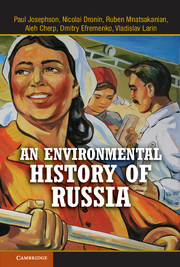Book contents
- Frontmatter
- Contents
- Introduction
- 1 From Imperial to Socialist Nature Preservation
- 2 Stalinism
- 3 The Khrushchev Reforms, Environmental Politics, and the Awakening of Environmentalism, 1953–1964
- 4 Developed Socialism, Environmental Degradation, and the Time of Economic “Stagnation,” 1964–1985
- 5 Gorbachev's Reforms, Glasnost, and Econationalism
- Conclusion After the Breakup of the Soviet Union
- Index
- References
5 - Gorbachev's Reforms, Glasnost, and Econationalism
Published online by Cambridge University Press: 05 April 2013
- Frontmatter
- Contents
- Introduction
- 1 From Imperial to Socialist Nature Preservation
- 2 Stalinism
- 3 The Khrushchev Reforms, Environmental Politics, and the Awakening of Environmentalism, 1953–1964
- 4 Developed Socialism, Environmental Degradation, and the Time of Economic “Stagnation,” 1964–1985
- 5 Gorbachev's Reforms, Glasnost, and Econationalism
- Conclusion After the Breakup of the Soviet Union
- Index
- References
Summary
During the brief era of leadership of the Soviet Union of Mikhail Gorbachev (1985–1991), civil society was born – or reborn – in public participation concerning a wide variety of issues in which environmental concerns began to occupy a central position. Gorbachev's policies of perestroika (restructuring, revolution) and glasnost (openness) at first encouraged public involvement, although he thought he could control its extent; ultimately, he could not shape or control the forces of political change he had supported with the goal of revitalizing the Soviet system. Indeed, openness shed direct light on the nature of that system – the high level of corruption among officials; the waning support among citizens; the shocking environmental costs of the Soviet development model; and the recognition that talk of the advantages of socialism had become empty sloganeering, in particular after the Chernobyl disaster in 1986 that became a symbol for endemic technological failure, pollution, and profligate use of natural resources. Two years later, in connection with campaigns for a new legislative body, the Congress of Peoples’ Deputies, political parties, interest groups, and nongovernmental organizations (NGOs) formed that insisted on both investigation of the past and a new path to the socialist future, many of which were concerned with the environment.
- Type
- Chapter
- Information
- An Environmental History of Russia , pp. 254 - 286Publisher: Cambridge University PressPrint publication year: 2013



